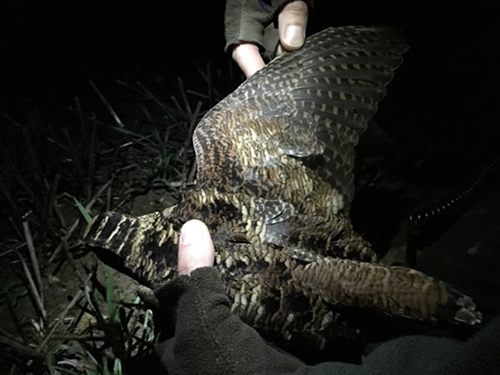By Lizzie Grayshon, Waders for Real Project Ecologist.
One of the great things about working in the GWCT's wetlands department is that we get to do field work all year round. As a keen bird ringer myself it is great to get out with the Woodcock Watch team to ring some Woodcock over the winter months.
They pick a wet, windy night around the new moon so that it is as dark as possible. By doing this there is a higher chance that you will be able to creep close enough to feeding woodcock to spotlight them before they fly away. Although these sound like quite miserable conditions, this is all forgotten once you catch a bird. They are fantastic birds, rather unusual looking but beautiful.
Once you are kitted out with as many layers as you can and a silent outer layer you walk into a dark wet field. You walk behind the catcher making sure not to get in the light, a woodcock is spotted by the eye-shine that is reflected from the spotlight. The catcher approaches very slowly with the spotlight. When they are close enough they place the hand net gently on top of the bird and then run quickly to restrain the bird. This skill comes from hours and hours or practice and they make it look very easy.

When a bird is caught both legs are checked for rings, if it has not been ringed before then a new metal ring is fitted. Each ring has a unique number on it so if caught again we know exactly which bird it is.
Several biometrics are then taken including wing length, bill length and weight. By examining the feathers we are able to distinguish between young (first year) and old (at least 1 year old or older) birds.
A calculation is later used, using the bill length and tail length to distinguish between males and females; female are on average larger.
All catching and ringing is done under strict licence by trained individuals.

Here is Tom Oakley’s experience, he is our current Wetland Placement Student:
There is no better way to become familiar with a species than to observe and handle them in the wild and when it comes to the secretive Woodcock some expert lamping skills are required.
My first visit to a prime catching location could be described as surreal; I spent the night silently following Chris, an expert Woodcock researcher, catching glimpses of rabbits, hares and deer in the long beam of the spotlight as it swept over pasture and stubble.
Chris would pass the light over a barn owl, or a fieldfare and move quickly on. Abruptly the spotlight stops, Chris freezes and beckons for me to look directly along the beam from behind the spotlight. There in the grass is the iridescent jewel he has been searching for, the reflective eye of a Woodcock, sat still and hoping not to be seen.
On a quiet night when I need to stay at the field’s edge, keeping noise to a minimum, this process looks rather like an alien abduction from a 60’s TV show.
Finally, the net swoops down, and I can expect to see one of two things; a Woodcock flare up into the sky at the last possible moment, illuminated as the spotlight tracks it, or the net suddenly jumping with energy and then with the spotlight off hearing just noises of Chris placing the Woodcock, however reluctant, into a soft cloth bag.
What strange birds they are, when you finally handle one; big eyes at the top of the head for a wide field of vision, and a long beak at the bottom for probing the soil and finding worms. After seeing and handling numerous birds they begin to appear quite distinct, a grey and mottled re-catch ‘Old Man’ and a young bird that resembled ‘Phoebe’ (from Friends), both had GPS tags fitted this year.
After careful measurements and applying a ring to the right leg, the bird is released and the search begins again. As a student, these were not the kind of late nights I was expecting to be enjoying a few times a week, but what a fantastic and rare experience they are.
Please help our declining UK woodcock